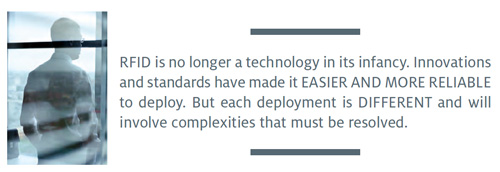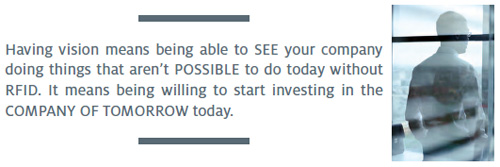Dec 01, 2012During the past 10 years, we've seen thousands of companies and organizations worldwide adopt radio frequency identification to solve myriad problems. They've deployed RFID in factories, hospitals and stores, on oil rigs and cruise ships, and at construction sites and ski resorts. They've tracked large pallets and small items, vehicles and apparel, workers and raw materials. And they've used many different types of RFID technology, including active and passive
systems.
Yet despite the diversity of industries and solutions, most of these companies have shared several experiences. They've deployed RFID on a project basis, learning about the technology, identifying a business problem that RFID could solve, piloting a system and evaluating the benefits. That was—and still is—the right approach for first-time users of RFID technology.
But many of the end users leading these pilots also have shared the frustration of struggling to get their RFID projects approved. Some were told the company couldn't afford to fund the project or the technology was too risky. Others were thwarted by concerns from coworkers who didn't want to disturb the status quo or risk their jobs if the project didn't work out. In fact, many projects never got green-lighted.
And there was little, if any, support from the top. In most cases, the CEOs did not have much knowledge of or interest in RFID. And if they were aware of the technology, they considered it a nuisance—an additional expense, something they wished would go away.
Now, suddenly, RFID is on the radar of many CEOs, as major aerospace and automobile companies, energy and IT firms, health-care organizations, hotels, manufacturers,
retailers and others deploy the technology on a large scale. Among those adopting an enterprise strategy for RFID are: Airbus, Boeing, BP, Cisco Systems, Daimler, Gerry Weber International, J.C. Penney, John Deere, Macy's, Rewe Group, Starwood Hotels and Resorts, and the Veterans Health Administration.
CEOs need to get up to speed quickly on the challenges and benefits of RFID, so they can
establish a corporate strategy for deploying the technology wisely. Those who do will position their companies to compete aggressively for years to come. CEOs who do not pick up the RFID reins will see their companies continue to struggle with inefficiencies, rising costs and decreasing market share. Here, then, are 10 facts CEOs must know about RFID, to ensure the technology delivers major benefits across the enterprise.
Many CEOs seem to believe RFID is just another technology, like customer relationship management software, data analytics software or cloud computing, that will be deployed during their tenure. If they are convinced RFID will deliver a return on investment, they sign off on a budget for the deployment and go on to the next issue. CEOs who take this approach will not see RFID deliver big benefits and are likely to see projects fail.
RFID is comparable in scope to the Internet. The Internet is not something that could be deployed and forgotten. It had and is still having a huge impact on the way companies collaborate, communicate, gather data, interact with customers, buy, sell and operate. In other words, the Internet permeates every corner of an organization. Some have managed the transition extremely well (think of how Cisco uses the Internet in every area of its operations), and some have not (think of all the retailers still struggling to develop a successful strategy to combat online merchants).
RFID will affect every aspect of the way a company does business—from how it monitors its supply-chain partners to how it interacts with customers. CEOs who get this will give RFID projects the priority needed to ensure success. That includes adequate funding and a focus on change management (see Fact 4).
Fact 2: RFID isn't a strategy—it's a technology that should support your company's strategy.
In the early days of the Internet, many Wall Street analysts would ask CEOs on earnings calls what their Internet strategy was. The thinking was a brick-and-mortar retailer had to launch its own online site, partner with an existing one or devise some other strategy to fend off dot-com competitors. Only now are retailers (and analysts) realizing that the Internet isn't a strategy. It's part of a broader infrastructure that allows a company to execute on its strategy more effectively and sometimes in new ways.
RFID is not a strategy, either. It's a tool that can help you compete more effectively by supporting your company's core strategy. If you are a retailer focused on giving customers goods at the lowest price imaginable, you could use RFID to reduce supply-chain waste and costs. If you are a high-end retailer that sells expensive goods with a personalized touch, you could use RFID to reduce theft and improve customer service (being able to answer questions about product availability and location with 100 percent accuracy might well be part of that).
Some manufacturers might adopt RFID to remain competitive by lowering costs. RFID could help them reduce safety stocks of parts, eliminate production delays caused by parts reaching the line late, and prevent errors by ensuring the right tool is used consistently. Other manufacturers might focus on putting RFID into products, either to reduce counterfeiting or to increase functionality and thereby appeal to more consumers.
This seems straightforward, even simple—just create a steering committee from different
departments within the enterprise and put the CIO in charge. That might work, but it might not, because a team leader needs to possess a special set of business and people skills. The RFID team leader should be someone with business acumen and the ability to focus on the business benefits of using RFID. He or she should be skeptical of transformation claims, require proof that the technology can deliver benefits and have the vision to see the potential benefits, even when they aren't apparent to everyone else.
A qualified team leader will face numerous challenges from within your organization. The leader you choose will not succeed unless it's clear to everyone in the company that he or she has your complete support.
Fact 4: Change management is critical.
There is no doubt that over the past 10 years, the biggest reason some RFID projects have failed to deliver benefits is that companies have failed to manage change. Several hospitals, for example, deployed an RFID-based real-time location system (RTLS) to track IV pumps and other assets, but never trained nurses—or gave them just cursory training—on how to use the system. Consequently, after struggling to use the RTLS to find equipment, the nurses gave up and returned to looking for assets the old way, by walking the floor.
Change is hard. People will resist it. Your employees need to understand the benefits of the RFID system and why the change is required. They need to be trained to use a new RFID system or do their jobs a new way. And they need management to insist on doing things the new way.
Many CEOs reflexively say RFID is much more expensive than bar codes, so there's no reason to switch. Bar codes, after all, can be printed on a package or label for virtually no additional cost, whereas tracking goods with RFID could cost 25 cents per item.
There are two problems with this comparison. First, it factors in only the cost of the data carriers (bar-code labels and RFID transponders) and not the cost of capturing the data. It's expensive to employ store associates or warehouse workers to scan bar codes. Numerous studies in the apparel retail sector, for example, have proven that taking inventory with RFID is faster and more accurate than scanning bar codes. So while RFID doesn't reduce costs, it enables companies to take inventory weekly, rather than once or twice a year, without a lot of extra labor costs; that improves inventory accuracy, which can lead to higher sales.
The other problem with comparing the cost of bar codes and RFID is it prevents companies from exploring RFID's potential benefits. The CEO of a consumer goods manufacturer, for
instance, might assume that putting a 20-cent tag on a case of shampoo is too expensive,
because the profit margin on that case is only $1 and RFID would eat up 20 percent of it. But RFID might allow the company to collect data that would improve efficiencies, which could save 25 cents per case, increasing the margin by 5 percent.
Fact 6: Your company is not as efficient as you think.
Many CEOs say they don't need RFID because they have 99 percent inventory accuracy in their stores or warehouses. Their inventory- and warehouse-management systems might tell them that, but the reality is few CEOs know how inefficient their operations are. Studies conducted by Auburn University and the University of Arkansas with many U.S. retailers, for example, found that, on average, inventory accuracy is 60 percent or less. Those same studies have shown that RFID can improve inventory accuracy to more than 95 percent.
Without RFID, there is no cost-effective way to track physical objects, such as inventory, parts, IT assets, vehicles and containers.
With RFID, warehouse managers can improve inventory accuracy and reduce the time
workers spend looking for misplaced goods. And they can manage other operations more effectively, such as shipping and receiving processes. That, in turn, reduces errors and improves customer satisfaction.
RFID, like the Internet, is an enabling technology. And just as the Internet can be used to exchange e-mail, share documents, provide information to the public, sell goods and services and support many other applications, RFID can help companies improve myriad operations and services. Once you become aware of all the benefits RFID can provide, there's a tendency to want to tackle all your business problems at once. But it's important not to try to boil the ocean.
Instead, establish a vision for using RFID throughout your operations, but begin with small tactical projects that are relatively easy to deploy (and are therefore likely to succeed) and will deliver a near-term ROI. In other words, don't invest in a system that will solve one problem but not work for other applications. You want to be able to roll out successive projects in stages, with each project delivering tangible benefits and advancing the company's overall business strategy (see Fact 2).
When you're focused and disciplined about prioritizing projects, you increase the likelihood that each new project will be managed properly and deliver the expected benefits.
Fact 8: The technology part is neither as hard nor as easy as people say.
If a CEO is getting a pitch from an RFID solution provider, he or she will likely hear that RFID is easy to deploy and there will be no hiccups. If the CEO is talking to an uninformed consultant or an executive at another company that is considering deploying RFID, he or she will likely hear that the technology is extremely complex, and the chances of success are small.
Neither extreme is true. RFID is no longer a technology in its infancy. Technology innovations and standards have made it easier and more reliable to deploy both passive and active systems. But each deployment is different and will involve complexities that must be resolved. As with any technology project, it's essential to choose the right partners. There are many skilled systems integrators with solid RFID experience who can help you determine where and how to deploy the technology.
RFID Journal writes about RFID technology in all its forms, but it's important to understand that when we refer to RFID infrastructure, we are using the term as shorthand for automatic data-collection tools. RFID is all about the data, which can give managers a complete picture of the location and movement of everything in the real world in real or near-real time. RFID provides visibility into the "what," "when" and "where" of pallets, cases and items. RFID also adds the "why" and "how"—and that transforms a data-collection tool into a powerful knowledge-gathering
resource.
Fact 10: You need vision if you really want to benefit from RFID.
The RFID industry and RFID technology have come a long way over the past 10 years. Many adopters have achieved benefits, but most of these benefits have been incremental. RFID has the potential to deliver a great deal more—if you have a vision of how RFID can bring transformational change. That might mean undermining Amazon by using your visibility into inventory accuracy in stores to provide same-day deliveries to customers that order online. Or maybe it is a patient-friendly hospital that uses RFID to ensure services are delivered in a timely and efficient way. Or perhaps it's becoming the manufacturing company that delivers the correct items at the right time every time.
In fact, RFID's benefits can be off the charts. RFID Journal writers and editors have encountered numerous examples of pilot results that were dismissed because they were too good to be true. In one case, a retailer saw a 20 percent increase in sales, but the CEO refused to believe any technology could deliver that kind of benefit. The project was killed, which was an unfortunate decision. Today, many retailers using RFID in stores are reporting unprecedented benefits. American Apparel, for instance, is adopting RFID at every store, because the technology has proven to increase inventory accuracy and reduce the incidence of shrinkage due to employee theft or error.
Internal shrinkage has dropped by up to 75 percent at some RFID-enabled locations, and by an average of 55 percent overall. Airbus uses RFID across its value chain to bring visibility and benefits to all areas of its operations. Among the many benefits the airplane maker has achieved is a 90 percent decrease in the amount of time employees spend receiving goods into inventory. Tufts Medical Center, in Boston, deployed an RFID inventory-management system that enabled the hospital to save $1.5 million over a two-year period, and improve patient safety. Cisco Systems, which is using RFID to manage fixed assets at 70 U.S. data centers and research-and-development labs, saw a 118 percent improvement in its ability to count assets during audits.
Having vision means being able to see your company doing things that aren't possible to do today without RFID. It means being willing to start investing in the company of tomorrow today. And it means communicating that vision to everyone inside the company, so they buy into it and embrace the benefits the technology will deliver.
The single biggest decision a CEO needs to make about radio frequency identification is not
what kind of technology to use or what application to adopt, but who should head the RFID team.
Here are the skills and qualities your RFID team leader should possess.
Passion.
Deploying RFID on a large scale means bringing wholesale change to your organization. The team leader must be passionate about how the technology can improve the way your company does business, so he or she can get others to buy into changing the way they do things. Without passion, the team leader will not be able to weather the political backbiting.
Seniority.
The team leader needs to be high enough in the organization to have the clout to push through change. This individual should report directly to the CEO, to avoid undercutting by other senior executives. The CIO, for instance, might argue in high-level meetings that RFID should be made a lower priority than some pet project of his or hers. Once you choose a team leader, everyone must know that you have put your trust in that person.
Political skills.
Let's be clear: RFID can be perceived as a threat to everyone in the organization. If you decide to RFID-enable your warehouse, for instance, the warehouse manager may feel vulnerable. The team leader needs to bring operational people into the decision-making process so they will embrace the technology. Otherwise, they will resist change or even sabotage the RFID system. Appoint a team leader who understands political resistance to change and can deal with it diplomatically. You do not want anyone attempting to ram change down the organization's throat.
Broad experience within the business.
Many companies choose the CIO to head their RFID efforts, because he or she is in charge of technology. But unless the CIO has a strong business background, that is a mistake. The ideal RFID team leader has worked in a variety of areas of the company, such as supply chain, manufacturing and customer service. This helps in two ways. First, the leader will understand the challenges people in those parts of the business face and the objections to change they will have. Second, it means the leader will likely have contacts and relationships in those business areas, which will be helpful in building trust and getting people on board.
Project-management skills.
RFID applications can be complex, requiring a year or more to deploy. The project manager must be able to set milestones and ensure they are met, keep the organization focused (many people will work on an RFID project as part of an existing job), address problems before they get out of control and adhere to budgets.






